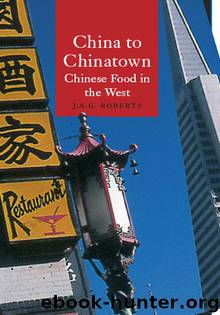China to Chinatown by J. A. G. Roberts

Author:J. A. G. Roberts
Language: eng
Format: epub
Publisher: Reaktion Books
THE 1884 HEALTH EXHIBITION IN LONDON
A small number of Chinese sailors had arrived in the East End of London by the end of the eighteenth century and throughout the nineteenth century small Chinese communities were to be found in London, Liverpool, Glasgow and Cardiff. By the 1880s the Limehouse district of London, which bordered on the West India Docks, had Chinese grocery stores, eating houses and meeting places. In Liverpool, a somewhat larger Chinese community had established itself in Pitt Street and neighbouring streets and there could be found a few provision stores and eating places serving Chinese seamen, dockworkers and students. There is no record of these eating places being patronized by Western customers and it seems unlikely that they were.11 At this time the main entrepreneurial activity of Chinese in Britain, as in North America, was laundry work. The first Chinese laundry in Britain opened in Newington in 1884 and by 1891 they were said to be springing up like mushrooms on Merseyside.12
The introduction of Chinese food in Britain took place under very different circumstances to those which prevailed in North America. In 1884 a Health Exhibition was held in South Kensington, London, with an international range of exhibits. One of its most popular attractions was a Chinese Restaurant. The arrangements for this, which included the supply of foodstuffs and the employment of cooks, were made in China by Robert Hart of the Chinese Maritime Customs. His response to the request to organize the Chinese stand illustrated Western misperceptions of Chinese eating habits:
The English idea of the Chinese Tea-House and Chinese Restaurant has nothing corresponding to it in China except the fact that there are buildings in which people can buy and eat food and drink tea: if we could supply you with one of them bodily, you would indeed have a slice out of the real life of China, but English sight-seers would neither eat in it nor sit in it, and the Committee would very soon beg us to move it out of that.
Nevertheless Hart sketched a plan for a restaurant and tea-house, and sent shop façades to London. Chinese cooks were recruited from Beijing and Guangzhou, and Hart wrote to his agent in London asking him to arrange their accommodation, telling him that ‘Chinamen can be packed close and they will not require palatial apartments.’ As for food, ‘rice, vegetables and salt fish and pork will be enough:- they are all more or less coolies so to speak’.13
The Chinese Restaurant opened a few weeks after the main exhibition had begun. The menu dated 11 September 1884 was written partly in French implying that Chinese cuisine was as sophisticated as that of France, but the names of some of the dishes suggested that some mockery was intended. It read as follows:
Download
This site does not store any files on its server. We only index and link to content provided by other sites. Please contact the content providers to delete copyright contents if any and email us, we'll remove relevant links or contents immediately.
Whiskies (Collins Gem) by dominic roskrow(45000)
101 Whiskies to Try Before You Die by Ian Buxton(44720)
World's Best Whiskies by Dominic Roskrow(44671)
Whiskies Galore by Ian Buxton(41770)
The Fast Metabolism Diet Cookbook by Haylie Pomroy(21037)
Chic & Unique Celebration Cakes by Zoe Clark(19923)
Craft Beer for the Homebrewer by Michael Agnew(18112)
The Bone Broth Miracle: How an Ancient Remedy Can Improve Health, Fight Aging, and Boost Beauty by Ariane Resnick(16524)
For the Love of Europe by Rick Steves(12539)
Tools of Titans by Timothy Ferriss(8178)
A Court of Wings and Ruin by Sarah J. Maas(7601)
How to Be a Bawse: A Guide to Conquering Life by Lilly Singh(7359)
The Institute by Stephen King(6899)
Cravings: Recipes for All the Food You Want to Eat by Chrissy Teigen & Adeena Sussman(6726)
Chowders and Soups by Liz Feltham(6678)
Wiseguy by Nicholas Pileggi(5635)
The Last Wish (The Witcher Book 1) by Andrzej Sapkowski(5368)
Spare by Prince Harry The Duke of Sussex(5034)
Room 212 by Kate Stewart(4998)
